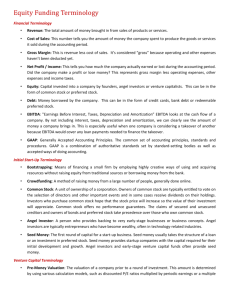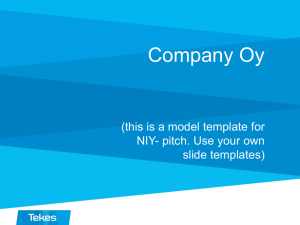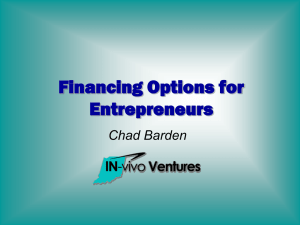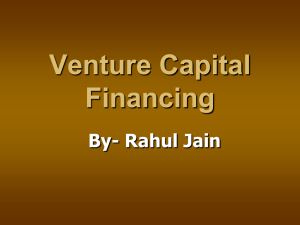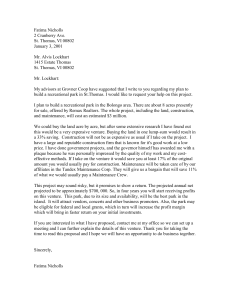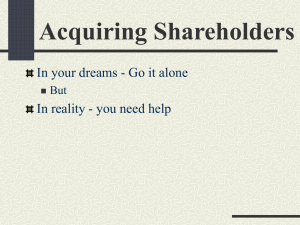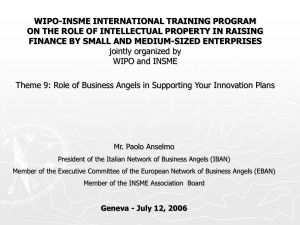Venture Business Plan Outline
advertisement
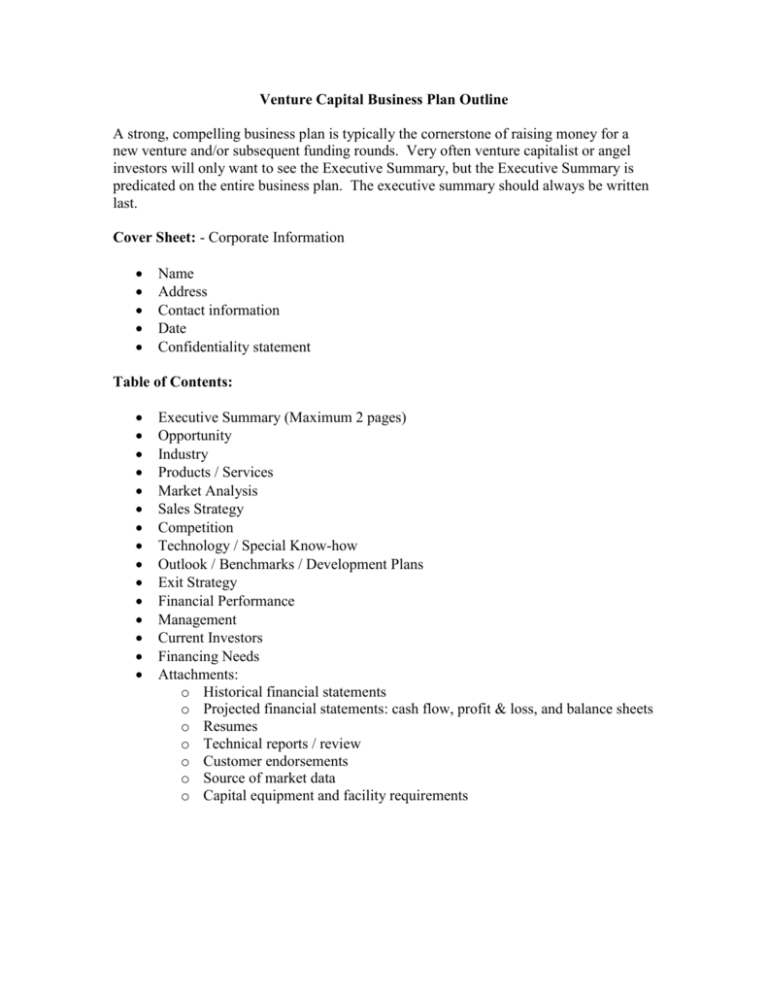
Venture Capital Business Plan Outline A strong, compelling business plan is typically the cornerstone of raising money for a new venture and/or subsequent funding rounds. Very often venture capitalist or angel investors will only want to see the Executive Summary, but the Executive Summary is predicated on the entire business plan. The executive summary should always be written last. Cover Sheet: - Corporate Information Name Address Contact information Date Confidentiality statement Table of Contents: Executive Summary (Maximum 2 pages) Opportunity Industry Products / Services Market Analysis Sales Strategy Competition Technology / Special Know-how Outlook / Benchmarks / Development Plans Exit Strategy Financial Performance Management Current Investors Financing Needs Attachments: o Historical financial statements o Projected financial statements: cash flow, profit & loss, and balance sheets o Resumes o Technical reports / review o Customer endorsements o Source of market data o Capital equipment and facility requirements Business Plan Narrative Executive Summary Opportunity: o Briefly describe the general nature of your company. From this section the investor must be convinced of the potential success of the business. Products/Service/Industry: o Convey to the investor that the company and product truly fill an unmet need in the marketplace. o The characteristics that set the product and company apart from the competition need to be identified (competitive advantage). o The industry and trends in which the company operates should be identified. o Also include analysts’ predictions for your industry or market segment. Market Analysis: o Provide a clear description of your target market and any market segments that may exist within that market. o Include potential market size and growth rate. Sales Strategy: o Provide a short summary of your company’s strategy for bringing your product/service to market. o Indicate specific steps that will be undertaken in this process. o Indicate which channels will be used to deliver your products/service to your target markets (i.e. website, direct sales force, VARs, channel partners, etc...) Competition: o List any current or potential direct and indirect competition. o Briefly describe the competitive outlook and dynamics of the relevant market in which you will operate. o Highlight current and future barriers to entry. Technologies / Special Know-how: o Highlight any aspects of your product that may be protected by current IP or patent law. o Provide evidence of how your offerings are different from the competition. Outlook / Benchmarks / Timelines: o Describe the major events that will take place in the short and long-term future (i.e. product launch, acquisition of first customer, milestones for customer base growth or sales growth). Exit Strategy: o Describe investors’ potential exit strategy. Financial Performance: o This section should highlight revenues, gross profit margins and income, both historical and projected for five years. Management: o Include qualifications and experience of current and/or to be hired key personnel: e.g. CEO, VP Sale/Mktg., VP Product Development, CTO, CFO, etc... Current Investors: o List private investors (angels), investment banks, venture capitalists and/or personal funds. o Give amounts and percentage ownership. Financing: o Describe current financing or banking arrangements, if any. o Also include amount of financing sought and proposed use of funds. Opportunity What problem will your company’s product or service solve? What is the Value Proposition? (economic benefit of solving the problem) Why will your company be successful? Demonstrable customer demand Industry Description of the industry in which your company operates or will operate: o Structure o Size o Major factors affecting market growth o Industry trends o Market trends o Competitive environment o New entrants o Key technologies Products / Services Differences between what is currently on the market and what you will offer Detail each product or service: o Primary end use and significant secondary applications o Benefits of product o Unique features o Any possible drawbacks of the product or service o Present state of development of the product o Time and money required to fully develop, test, and introduce Competitive advantage over the competition Opportunities for the expansion of the product line Market Analysis Customers: o Existing customers o Potential customers o Customers’ buying processes o Current orders, contracts, or letters of commitment Market size and trends: o Size of current total market Demonstrable customer demand o Market segments Market shares by market segment o Potential growth for each market segment Ability of company to grow and obtain market share Potential sales and market share Sales Strategy Marketing strategy: o Marketing philosophy o Value chain and channels of distribution in the market segments Pricing: o Pricing policy compared with those of your major competitors o Gross profit margin (indicate whether this margin is large enough to allow for distribution and sales warranty, training, service, etc.) o Comparative pricing strategy for competitive or substitute products Sales tactics: o Channels of distribution by market segment o Value chain and margins for each segment o Sales force structure Internal External Management process Service and warranty policies, if applicable Advertising and promotion: o Advertising vehicles For manufacturers of industrial products Trade show Trade magazine advertisements Direct mailings Internet Other Consumer products Advertising Promotional campaign Internet Direct mail Other Competition Strengths and weaknesses of competitors Substitute and/or alternative products Comparison with your product: o Price, performance, delivery, timing, service, warranties, financial strength, distribution methods, production capability and other pertinent features Comparison of fundamental values Advantages and disadvantages of products Category leaders, new constraints, drop outs Assessment of future competitive environment Barriers to entry Technology/Special Know-how Development status of product(s): o Time frame o Resource requirements o Difficulties and risks o Design or development stages Technological advantage: o Patent, trademark, copyright, or intellectual property rights o Extent of search for infringement licenses Contractual rights Any unresolved issues Confirming data and/or experts Product improvement and new products: o Costs o Time frame o Resource requirements o Difficulties and risks o Design or development stages Manufacturing and Operations Facilities and improvements: o Location(s) o Plant(s) o Office space(s) o Timing Machinery and other capital equipment: o Special tooling Future capital needs: o Timing o Cost Operating cycle: o Manufacturing processes o Quality control, production control, inventory control Strategy and plans: o Make-or-buy policy o Subcontractors and/or suppliers Regulatory and legal issues Outlook / Benchmarks / Development Plans Milestones: o Complete management team o Product development stages (proto-type, etc.) o Production capability o Customer acquisition o Breakeven o Cash flow positive o Funding Risks: o Development / technical o Competitive o Production / supply o Financial Exit Strategy Alternative opportunities Anticipated return on investment Most likely strategy Timing Financial Performance Discussion of historical financial performance Discussion of projected financial performance: o Assumptions (bottom up, not market share) o Revenues o Margins o Cash flow o Breakeven Capitalization: o Current o Projected Management Organization: o Roles and individuals o Open positions Key management personnel: o Experience o Achievements o Ability to perform within this team o Identified future employees Board of directors or advisors Other consultants or advisors Current Investors Names (and type e.g. Angel) Type of ownership Percentage Rights Financing Needs Amount of funding Purpose Timing Future financing needs This material has been taken from several sources including, but not limited to: 1. Presentations by: Massachusetts Technology Development Corp., Bay Angels, CommonAngels, Blue Rock Capital, Telecommunications Development Fund, Zero Stage Capital and 2. New Venture Creation: Entrepreneurship in the 21st Century by Jeffry A. Timmons, Irwin McGraw Hill 1994.

